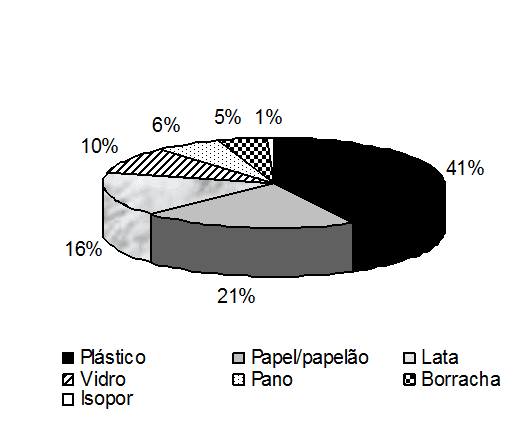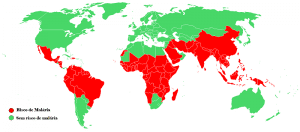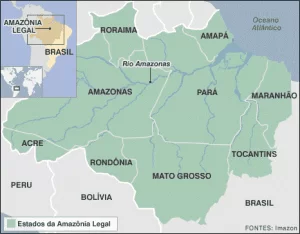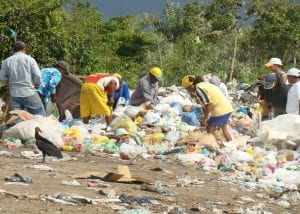OLIVEIRA, Euzébio de [1]
OLIVEIRA, Euzébio de. Social and environmental assessment of the community of Tamatateua, Amazonian Brazilian Coastline. Multidisciplinary Core scientific journal of knowledge. Year 1, vol. 5, pp. 37-57, ISSN: 0959-2448
SUMMARY
The present study addresses the social, economic and environmental aspects of Tamatateua, a agro-pesqueira community, located on the northeast coast of the State of Pará, Brazil. This community is located in the area that comprises the Marine extractive reserve Caeté-Taperaçu. This study was conducted through interviews, use of questionnaires, direct observation and measurement of the main environmental problems, following specific methodologies. The results showed that this community has a precarious socio-economic situation and is characterized by a young population, with low educational level, which survives on less than one minimum wage per month. The community presents problems related to the lack of services and infrastructure, and the misuse of natural resources. Lack of interest of the Government to invest in public services and oversee/penalizing the exploitation of natural resources in the area of the PROTECTED AREA. Proposals for participatory coastal management measures were launched in this work aimed at improving the quality of life and environment in the study area.
Key words: social and Environmental Degradation, use and territorial occupation, the coastal area.
1. INTRODUCTION
In recent years, the coastal ecosystems have undergone serious changes, mainly in response to the large human population growth and economic activities developed in these regions (Jiang et al., 2001; Billé & Mermet, 2002). Natural and anthropic character processes in regional and global scope, such as sea level rise, climate change, disorderly urbanization, deforestation, pollution of seas, estuaries and rivers, among others have been responsible for commitment (quali-quantitative) of existing natural resources in these ecosystems (REID; TREXLER, 1992; WEAVER; GREEN, 1998; Souza; NEUMANN, 2000).
The Brazil has approximately 7,408 km of coastline, and that about 70% of the brazilian population inhabits the main urban centres along the coast (CNIO, 1998). The Amazonian brazilian coast represents about 35% of the coastline, in the country and is formed by the States of Amapá, Pará and Maranhão that together make up more than 2,500 km (Isaac & Barthem, 1995). This region has a naturally Rico and very productive, biologically, with large areas of mangroves, estuaries, rivers and tropical forests, featuring fauna and flora very unique and varied, that interconnect both terrestrial environments as (CH; RIZZO, 1994; GLASER, 2003).
In the northeast of the State of Pará, studies show that the increasing pressure on ecosystems, existing there, has generated various environmental problems, as a result of deforestation, disorderly occupation, lack of services and infrastructure, contamination of soil and water system, predatory extraction of fish stocks, among others (SILVA et al., 2006; PARKER et al., 2006A; PARKER et al., 2007).
Among the municipalities in the State, NE Portugal stands out for having one of the greatest potential for exploitation of the fisheries resources of the region (KRAUSE; GLASER, 2003), having been considered, in the 90, the third largest centre for landing State fish (ESPÍRITO SANTO et al., 2005), as well as one of the largest agricultural producers in the region. Among the various existing rural communities in the municipality of Bragança, the agro-pesqueira community of Tamatateua stands out for being inserted into the Marine extractive reserve Caeté-Taperaçu (MMA, 2005).
In this context, the objective of this work was to study the social and environmental aspects of Tamatateua, as well as propose management measures for the rural Caeté RESEX-Taperaçu, using the Tamatateua community as a case study, since it presents a representative population density and a relatively structured social organization, compared to the other members of this marine PROTECTED AREA communities. To achieve this it was necessary to meet the socio-economic profile of the residents, determine the types of use and local territorial occupation, as well as characterize the main environmental problems detected. Finally, proposals for participatory coastal management measures have been launched, aimed at improving the quality of life and the environment of rural communities located in this conservation area.
2. METHODOLOGY
2.1 STUDT AREA
The Tamatateua community is located north of the city centre of Bragança, northeastern coast of the State of Pará, one of the agro-pesqueiras communities inserted into the Marine extractive reserve Caeté-Taperaçu (MMA, 2005). (Figure 1).
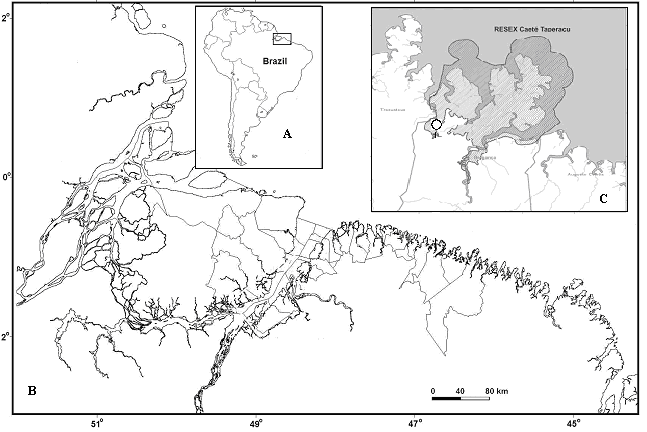
The region’s climate is hot and humid, with a rainy season during the months of December to may and a dry season, or less rain, in the remaining months of the year. Average annual rainfall varies from 2,500 to 3,000 mm. The temperature lies between 20.4° C and 32.8° C, with an average of 26.6° c. The relative humidity is between 80 and 91% (INMET, 1992; MARTORANO et al., 1993).
The Bragantina coastal plain is characterized by the occurrence of mangroves occupying 95% of the entire coastal area, and the mangrove forests composed basically by the species of Rhizophora mangle, Avicennia germinans and Laguncularia racemosa, and r. mangle the dominant species (MARQUES et al., 1997; PROISY et al., 2003).
Tamatateua natural fields are covered mainly by reeds (Aleucharis sp) and aquatic macrófilas, that during the rainy season become flooded fields that serve as a source of water and pasture for livestock (beef and bubalino), as well as Habitat for various species of fish, which are used as food supplement (subsistence fishing) for some local families (OLIVEIRA , 2005).
2.2 METODOLOGICOS PROCEDURES
To evaluate in an integrated manner the different social, economic and environmental aspects of the community being studied, different methodological tools were used: questionnaires, interviews, direct observation and measurement of some factors of environmental degradation.
First semi-sistemáticos questionnaires were applied, composed of three blocks of questions (socio-economic profile, condition of life and housing and opinion and perception of the residents about the environmental problems). This work was carried out on 100% of the residences.
For the characterization of the socioeconomic profile of all residents were raised information about age, sex, marital status, education, occupation/profession and income.
The housing and living condition of the inhabitants of each residence was determined through survey of the physical aspects of the domicile (roof type, construction and floor, and bathroom), public services available (destination of sanitary waste, electricity, water supply, transport and garbage collection) and the situation of the property (own, rented, of family and/or overrun). To determine the condition of life and minimum acceptable housing was used the index of living conditions and housing (ICV-MO) which was calculated according to the methodology described by Costa (2004), following the pattern used by the socio-economic development index developed by the Foundation of Economics and statistics (IDESE/FEE) through the formula (ICV-MO = (p1 x IAF) + (p2 x ISP) + (p3 x IP)) , and IAF the physical aspects of housing, ISP public services available to the community and the IP the situation of the property.
With respect to the opinion and perception of residents about environmental problems, the questionnaires were drawn up in accordance with the work of Morgan et al. (1995) and LEATHERMAN (1997) and applied to a member of each residence.
The types of infrastructure and services available to the Community (eg. health, sanitation, education, transport, etc.) were raised at the same time the application of semi-sistemáticos questionnaires, from direct observation, following the methodology of check list, administered by JUNYENT (1999) and PEREIRA et al. (2003), adapted to the local reality, as well as through interviews.
Based on the opinion and perception of the residents, as well as on direct observation carried out in relation to infrastructure and services available and the environmental condition of the community, specific methodologies were adopted to measure/analyze some environmental problems pointed/detected, such as: the accumulation of domestic waste, water quality, deforestation and land use for agriculture.
Below follows the methodology applied:
(i) production of household waste: was first analyzed the fate given to garbage (collected by the city, burned, buried, dumped in vacant lots, fields, etc.) Then, the job of measuring the garbage was carried out by means of two samples, one at the end of September and the other at the beginning of November 2006, each sample represented by waste produced during two days in 30% of the total number of houses in the community. Based on the average of the two samples was estimated production of monthly garbage to 100% of the residences in the community. Each sample collected the organic waste (unrecycled) was heavy separately from inorganic garbage (recyclable), then analysis of variance were performed (beginning and end of the month). To determine the normality and homogeneity of the data was performed the Lilliefors test (CONOVER, 1971) and Bartlett’s (SOKAL; ROHLF, 1969), respectively, with the aid of the program STATISTICA 6.0 (STATSOFT, 2001). When the data did not show a normal distribution, log transformations were used (x + 1). For normal data was applied to analysis of variance (ANOVA-one-way), followed by post-hoc test Fisher LSD. But when the variances were heterogeneous test was applied non-parametric Mann-Whitney test (U). The works were carried out based on the manual “corporate commitment to recycling” (1995), and in the manual “integrated solid waste Management in the Amazon” (IBAM, 2005), being both methodologies adapted to the local reality.
(ii) water quality: the collection of the samples was carried out during the dry season (November) and the rainy season (March) in two community wells. The well 1 is situated in the port of Atalaia (46 ‘ 44 ” W 42,123 – 1st 3 ‘ 6.73 ” S) and well 2 at the school of the four burners (46.47 ‘ 16,237 ” W-0° 56 ‘ 9,037 ” S). These wells were chosen for having great importance, in view of a large number of residents of the community. All physicochemical analyses were performed in the laboratory of Estuarine and coastal Oceanography of the UFPA, following methodologies and/or using specific equipment for each variable studied. The actual color and apparent was analyzed by the Color of water equipment HI 93727 Hannna Instrument, the turbidity by Turbidity Meter HI Hanna 93703 Microprocessor Instrument, the pH by Labmeter model pH2-pHs-3B, the salinity by Multianalizador Corning Checkmate II, the temperature by the Thermometer Incoterm L-168/04, the iron dissolved by Hardness & Iron HI 93741 Hanna Instrument, and the faecal coliforms and totals from the technique called multiple tubes by following the procedures of the American Public Health Association (2004). For the classification of water quality, the procedures were carried out using the parameters laid down by specific resolutions, according to ANVISA (2004) and CONAMA (1986; 2000; 2005).
(iii) Deforestation (logging): deforestation was measured based on the answers obtained by interviews and questionnaires to residents of the community, which addressed questions relating to the extraction plant (cut or mangue), as well as through direct observations, based on the method of Greenwood (1973).
(iv) land use for agriculture: through questionnaires and direct observations were identified the areas of cultivation, types of farming practices and soil management techniques more employed in the community under study, such as the form of plowing the land, use of pesticides and fertilizers; cut down of capoeira and burned. Following the method of Greenwood (1973).
3. RESULTS AND DISCUSSIONS
3.1 SOCIO-ECONOMIC PROFILE
The population of Tamatateua is of 966 people, totaling 207 households, with an average value of 4.66 persons per house. Most residents are young (20 years-52%) <, male (55%), single (62%), and with incomplete basic education (60%). Among the activities of occupation/profession carried out by total population, family farming represents 48%, followed by 35%, fishing student 9%, 3%, retired civil servant 2% and others 3%. It is important to stress that the fishery activity appears with only 9%, due to the autodenominação of occupation (farmer) given by employees of that community, however fishing is conducted as a parallel and complementary activity for virtually all those who practise agriculture, terming this community of agro-pesqueira. On the other hand, 64% of families survive on less than one minimum wage per month.
The low per capita income, possibly, is the consequence of the low level of schooling that the villagers of Tamatateua have, as well as the lack of options for economic activities (GRASSO, 2000). These results are similar to those that Krause; Glaser (2003), Silva et al. (2006), Pereira et al. (2006a) and Pereira et al. (2006b) found in similar studies conducted in other communities the bragantina region, a fact that proves the hard social and economic reality of the populations included in the Amazonian coast.
On the other hand, this community offers a good structure in terms of community associations e.g. residents ‘ Association, Association of honey producers, women’s Association, among others. Among the main achievements of the associations include the rural funding, which have assisted the family agriculture, and other activities that come from contributing to sustainable development, such as location, extraction/production of honey. These events are related directly to the establishment of social capital (BERKES; FOLKE, 1998) and the local leadership, which are badly needed in the prerequisites, collaborations and/or cooperation of national and/or international bodies (KLOSE et al., 2005), aimed at the development of Community actions to improve the quality of life of rural populations.
3.2 LIVING CONDITIONS AND HOUSING/INFRASTRUCTURE AND SERVICES
With respect to the index of living conditions and housing ICV-MO, Tamatateua community, the median was lower than the value 0.548 minimum acceptable condition which is 0.707, according to Socioeconomic development index created by the Foundation of Economics and statistics (IDESE/FEE). This fact is due to the precariousness of the physical and health aspects of housing and infrastructure and public services available to the population. Most of the houses are of mud, with dirt floor hit, some covered with straw (dried palm leaves), not having a bathroom or running water system and/or treated, the water used for consumption of the population comes from wells dug in the grounds are common of the houses, often near the black pits that do not receive any kind of treatment. According to Sanchez-Gil et al. (2004), the absence of social and economic development, arising mainly from the few options of economic activities in fishing communities, is undoubtedly the major cause of the problems of the physical structure of these residences.
The community has no sewage treatment system, as well as garbage collection. Tamatateua also has health centers, and in the most serious situations, the service is held at the Bacuriteua community health or in hospitals and/or posts municipality of Bragança. The most frequent diseases are: malaria, flu, diarrhea, viral infections and skin diseases. According to the residents, malaria is a disease that comes to reaching the community in recent years, and according to Rodrigues; Moreira (2006), this fact is associated mainly to the lack of basic sanitation and increased deforestation in the region.
As to education, the community is served by only three public schools, offering primary education incomplete. Those interested in continuing their studies, the only option is the schools in the municipality of Bragança, which despite the municipal public transport be offered free, the other costs of education, allied to the few options of schedules of school buses, are factors that prevent or hinder the continuity of studies between most of the locals, which justifies the low educational level of the local population. Similar results were found in other studies carried out in rural communities of the Amazon coast (KRAUSE et al., 2000; GLASER, 2003; KRAUSE; GLASER, 2003).
ICV-MO studies performed by Costa (2004), in coastal communities in southern Brazil, show that the low values of the indexes found in these communities, both the North and the South of the country, are not considered ideal, and that these low rates are due, mainly, of the problems of access to public services and infrastructure, as well as gradually or ineffective social investments and/or lack of Government incentives applied in these areas.
3.3 SOCIAL AND ENVIRONMENTAL PERCEPTION AND OPINION
According to the opinion and social and environmental awareness of residents (table 1), the main problems are related to the precariousness of public services, principally to the lack of basic sanitation (garbage collection, water supply and sanitary network and sewage treatment), as well as the degradation and/or misuse of natural resources (reduction of fish stocks and forests, over-fishing , mangrove deforestation and reduced soil fertility).
Table 1. Main environmental problems pointed to by the population of Tamatateua-PA.
| -Environmental Problems | Frequency of Answers * | % |
| 1-arising from the lack of sanitation | ||
| Presence of garbage in residential area of community | 128 | 62 |
| Presence of trash in the area of mangroves and rivers | 74 | 36 |
| Diseases due to contaminated water and lack of sewage system | 62 | 30 |
| Soil degradation by accumulation of garbage and sewage | 37 | 18 |
| 2-arising from the degradation of natural resources | ||
| Reduction of fishing and forestry resources | 125 | 60 |
| Predatory/indiscriminate fishing (fish, crab, etc.) | 56 | 27 |
| Deforestation of mangroves | 50 | 24 |
| Productivity/reducing soil fertility | 48 | 23 |
| 3-Other | ||
| Don’t know how to answer the questions | 09 | 04 |
| There are no environmental problems in the area of community | 27 | 13 |
* Frequency response for N = 207 (number of households).
Table 1 shows that only 4% of respondents didn’t know how to answer the questions, but 13% responded that there are no environmental problems in the area of the community.
According to the other responses, it was possible to notice that the population has a good opinion and perception about the main social and environmental problems that have been taking place in the area. However, the same, although present a good community structure, are pretty negative about future expectations in relation to environmental conservation, even aware of the fact that they are in a conservation area and that natural resources are the main source of local survival (OLIVEIRA, 2004).
3.4 PRODUCTION OF HOUSEHOLD WASTE
The study area has no public system of trash collection, and as a result, 30% of the studied houses throw their garbage in vacant lots, fields, estuaries, rivers, etc.; While 70% burn or bury the garbage. However, during the rainy season, the burning is not performed in the days of greatest precipitation and the waste produced is now played around the community e.g. streets, schools, rivers, mangroves, backyard of houses, etc.
Considering 100% of the residences of the community, the average monthly production of garbage is approximately 2,680.750 kg, showing a monthly per capita production of 2.775 kg, i.e. an average of ± 0.093 kg/day, being far below the national average production, which according to the IBAM (2005), in cities with less than 200,000 residents to production is the 0.700 0.450 kg/day per capita garbage. This daily average so low can be directly related to the issue of low income of most of its inhabitants, which raises major difficulties of access to consumer goods, as well as the issue of its geographical position, because Tamatateua is located in the countryside, are not entered in the “high cycle” of waste that occurs in the urban environment.
With the repetition of sampling, it was possible to prove that there is an increase in the production of domestic waste at the beginning of the month (collection 2), tending to decrease at the end of the same (1 collection), this is due to the fact that earlier this month the families receive salaries, pensions, government benefits, etc. Although variations have occurred in the production of waste in the course of the month, these differences were not statistically significant (U = 1695; p = 0.8086).
Among the components of inorganic waste, plastic prevailed with 41% of the total value, followed by paper/cardboard with 20%, among others (figure 2A). Comparing the production of organic waste with the inorganic could not register significant differences (F = 3.62; p = 0.0595; F = 2.67; p = 0.1045, respectively) between samples 1 and 2, although the percentages of inorganic waste have been slightly higher than visually (Figure 2B), which differs from the “standard” national, in which about 65% of household waste, produced consists of organic waste.
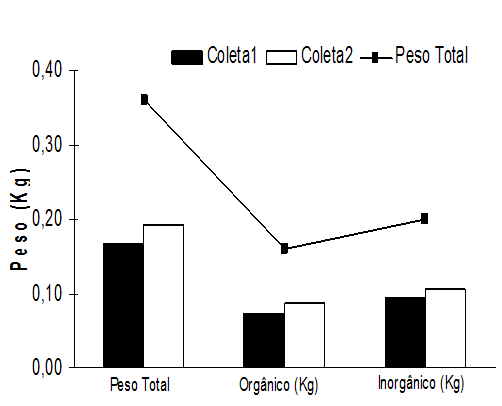
In Tamatateua, as well as in other coastal communities in the Amazon, the organic waste edible serves as food for many small animals, like duck, chicken, dog, etc. Although occur unintentionally, the community under study comes following the recommendations of Parsi (1996), with regard to treat and/or turn organic waste (food for animals), thereby reducing the environmental and health problems associated with the accumulation of the same.
However, the volume of solid waste produced in this area, coupled with the lack of the same collection are a serious threat to all ecosystems present (rivers, mangroves, estuaries, etc.), as well as to human health. Among the main sociambientais problems, arising from the accumulation of garbage site can be highlighted: the presence of vector (mosquitoes, flies, rats, roaches, etc.) that can cause diseases such as dengue fever, malaria, fungal infections, parasites, etc.; the contamination of soil and water resources; the production of gases that cause bad odor; In addition to the aesthetic and economic impacts (GRIMBERG; BANERJEE, 1998). Similar results were found in other communities of the North and Northeast region of the country (SOUZA-FILHO, 2001; AGUILAR; COSTA, 2003; PEREIRA et al., 2003; SILVA et al., 2006).
3.5 QUALITY OF WATER FOR CONSUMPTION
The lack of public supply of drinking water is one of the main problems presented in the community of Tamatateua. For this reason, various community and private wells were built throughout the community, however during a prolonged dry period, many of these wells dry up. On the other hand, the shallowness and/or the vicinity thereof, in relation to sanitary sewers, which occurs in some cases, can contribute to the quality of groundwater is compromised (AZEVEDO, 2006).
The results of the physical-chemical analysis performed in two wells show some variations in the concentration of its constituents in solution, which may be harmful to human health (table 2).
The actual color and color seeming very high values during the dry period in both wells analyzed, being far above the parameters established by the resolutions in force (table 2). Generally, the color variation of the water’s turbidity and/or related to the concentration of dissolved iron (birth; BARBOSA, 2005). In the area under study, these variables do not seem to influence directly the apparent and real color of the water, because only in the pit 2, during the rainy season, the iron appears with high value, period in which the water showed no color variation. However, according to ANVISA (2004) drinking water must not show any coloring.
| Parameters | Values
ideal * |
Well 1 | Well 2 | ||
| Dry Period | Rainy Season | Dry Period | Rainy Season | ||
| Actual color (mg Pt/L and UH) | < 20 | 70 | 0 | 120 | 0 |
| Apparent color (mg Pt/L and UH) | < 75 | 330 | 0 | 430 | 0 |
| Turbidity (UNT) | < 40 | 2.24 | 0 | 12.85 | 0.27 |
| Ph | -9.0 6.0 | 4.85 | 5.35 | 4.49 | 4.72 |
| Salinity | 0 | 0 | 0 | 0 | 0 |
| Temperature (ºc) | 26-29 | 28 C | 28.9° C | 29 C | 29 C |
| Dissolved iron (mg/L Fe) | 0.300 | 0.150 | 0.59 | 0.191 | 0.328 |
| Total coliforms (cfu/100 mL) 100100mL100100100mL) | < 1,0></ 1,0> | 0 | 0 | 9.2 | 240 |
| Fecal coliforms (cfu/100 mL) | 0 | 0 | 0 | 9.2 | 43 |
* Ideal Values of physico-chemical and microbiological variables, for drinking water, according to ANVISA specific resolutions (2004) and of the CONAMA (1986, 2000, 2005).
According to the pH, the acid and features analyzed water unfit for human consumption (CONAMA, 1989; ANVISA, 2004). Zero salinity may influence the low values of pH, however the presence of acidic soil, due to the concentration of organic matter in decomposition exists at this location, can be one of the main factors that directly influence the pH of the samples analysed. These data are consistent with the results found by Santos et al. (1981), in a study conducted in the region of central Amazonia, in which showed that the low pH values were assigned to excreted metabolic by microorganisms and exudates of decaying vegetation itself, very present in the study area.
As reported previously, the dissolved iron presents a slightly elevated values in pit 2, during the rainy season, and nonstandard allowed tolerance (< 0.3 mg/L). In addition to the yellowing of the water and the unpleasant taste, the high concentration of iron in the water can cause cancers, Parkinson’s disease, among other (DISSANAYAKE; CHANDRAJITH, 1999; SMITH; HUYCK, 1999). On the other hand, the presence of iron in water is also primarily responsible for the loss of specific capacity of deep wells (DREVER, 1997).
The presence of faecal coliforms and totals in the water is also another major problem locally. According to the results, note that the well 2 (school), in both periods the concentration of these microorganisms is high, beyond the permitted rates, mainly during the rainy season, when the concentration of these pathogens rises of 9.2 colony-forming units (CFU) to 240. This is probably because the dump site (fossa) of waste and kitchen and sanitary ware, produced in high school, is located less than 10 m water supply well, being totally out of technically established standards. According to Macintyre (1990) and Creder (1999), the pits must be located on a lower level of the ground and away from wells or other water source, respecting a minimum distance of 30 m, to avoid contamination by pathogens that may present a risk to human health.
Similar to these studies were performed by Glaser (2003), in some communities of Northeastern Pará, and the results indicate high faecal coliform presence in almost all households and schools monitored. Studies by Amaral et al. (2003) showed that in poor communities, the risk of contracting illnesses from contaminated water is much higher, since the knowledge on the part of the population, referring to these factors is minimal or non-existent.
Comparing the dry season and the rainy weather it was possible to observe that the water is unfit for consumption, in both wells and periods.
3.6 DEFORESTATION
In table 1 you can see that the question concerning the occurrence of mangrove deforestation in the area of the community, appears with a frequency of positive responses of 24% of the population. However, when asked about their own deforestation practices, 85% of respondents stated that perform cutting, but “being only capoeira trees”, and 15% did not perform any cutting, i.e., the deforestation of mangrove trees appears with 0%. Among those who perform the cutting, 94% use wood for domestic consumption, being used as fuel (wood), for the construction of houses and to surround residential and land areas of creation of small animals, while 4% use firewood consumption and to the production and sale of coal and 2% only for the production and sale of coal (Figure 3A).
The production of coal is a source of income for the poorest inhabitants of the adjacent mangrove areas and is based partly on wood from areas of capoeira who are dropped for agricultural crops and in mangrove areas logged timber (DAHDOU-GUEBAS et al., 2000).
The most used methods to obtain the wood in the study area are the partial-cutting only branches of trees (57%), the total cut-tree felling (36%), and other methods-like gathering of dry twigs and/or fallen trees (7%) (Figure 3B). Those who perform the cutting of trees, 37.28% know or ever heard of reforestation methods, and of these, only 3.38% participates or has participated in any such activity.
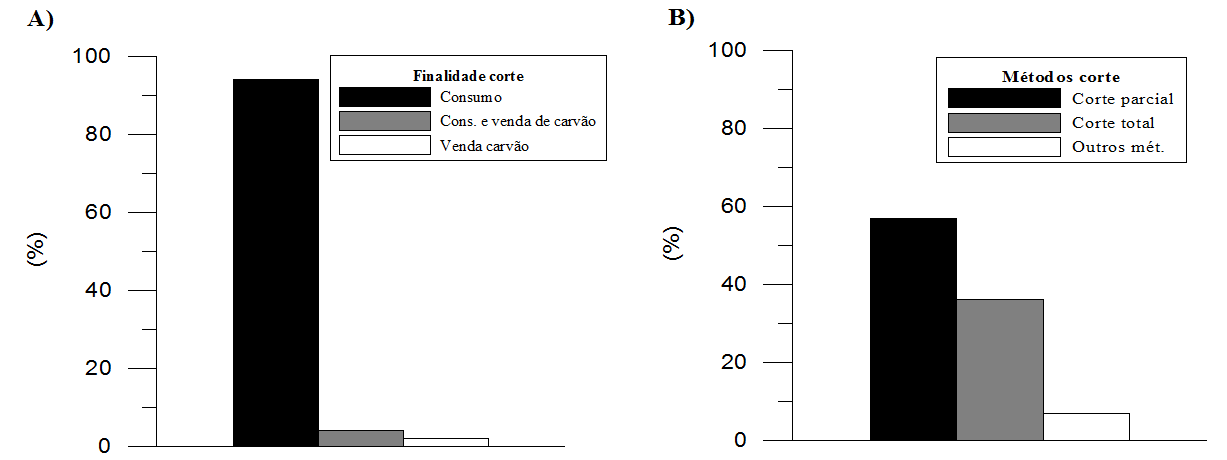
With the method of direct observation, it was possible to detect some mangrove areas surrounding the community, which are suffering the problem of cutting mangrove trees (figures 4A and 4B). This mangrove degradation factor is due, mainly, to commercial pressures, as the demand of the potteries and bakeries, which are located outside the search area, having little relation with local strategies aimed at sustainable use of the ecosystem (GLASER et al., 2003). According to these authors, at least half of the annual consumption of wood held by the potteries and the bragantina region bakeries is originally from mangrove, with preference for the species r. mangle, because of its heat retention qualities and good burns.
You can tell it, the practice of cutting of mangrove trees, not necessarily is performed by the community of Tamatateua and Glaser et al. (2003) comment that this practice is carried out by woodcutters from outside the community. These results on the one hand show awareness of the local population not to degrade the mangrove area, and on the other that there is no supervision nor of the population nor of IBAMA to prevent the cut performed by woodcutters from other communities.
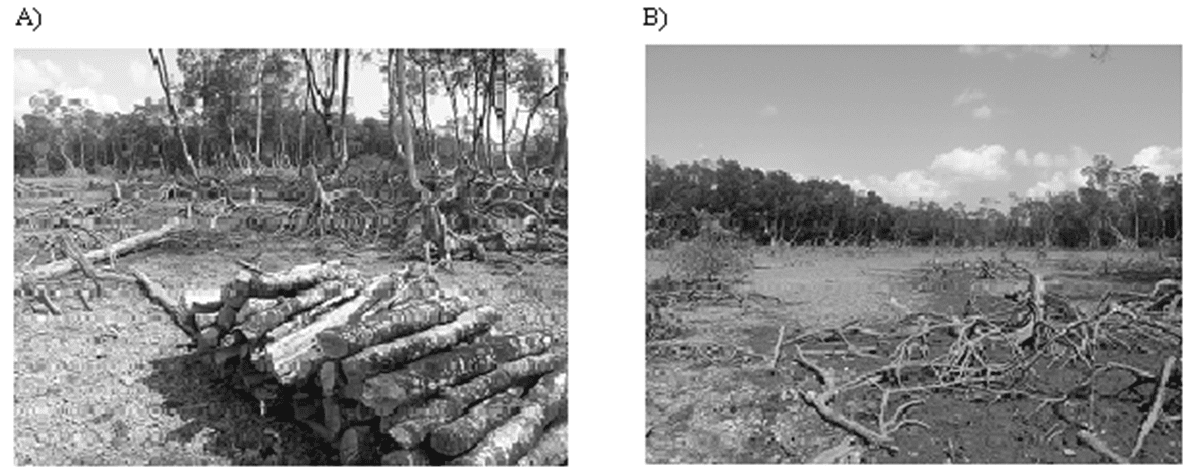
The awareness of the population not to degrade the local mangrove area, may be related to the fact that the community have community associations structured, in addition to the counted directly with national and international projects that have cleat, designed among others preservationist to environmental education.
3.7 LAND USE FOR AGRICULTURE
About 94% of the Tamatateua families practice family farming, and this practice the maintenance base of the families that make up the community. The predominant farming system is based on traditional methods, known as itinerant agriculture, in which consists of tips and burning of capoeira, and then the earth revolved, with using only hoes, for preparation of the areas to be cultivated. In General, the crops they last on average two years, and then again enter areas fallow (rest) for growth of capoeira (KATO et al., 1999).
Of the total output generated in these family units, 52.03% are intended solely for the consumption of the family, 46.40% for consumption and sale and 2.57% only for sale. The main farming products are cassava/manioc (Manihot esculenta), Cowpea (Vigna unguiculata), tobacco (Nicotiana tabacum) and corn (Zea mays). But those cultures generally suffer from a tendency of increase or decrease in production, according to the pressure of the consumer market and also with decreased soil quality. For 35% of farmers, soil fertility has decreased considerably over the past five years, falling agricultural production, which has forced the use of fertilisers/fertilizers. As a result, 53.60% of farmers have declared that they have practiced the fertilizing, and of these 82.70% use organic fertilizer produced in his own community (cattle dung).
The itinerant farming is increasingly being replaced by agriculture. Thus, there may be harvest twice a year by reducing the fallow period. This reduction in time off the ground was achieved due to the use of livestock manure as fertilizer, a local innovation (KLOSE et al., 2005); already in relation to the use of pesticides, 31.44% say they use or have used this method on their crops for the control of pests such as ants and “bean aphid” (Aphis rumicis), but most don’t say which product used. Note that the use of chemicals such as fertilizers and pesticides are soluble occurring in the Community area.
Soluble fertilizers a determined point of view are good, being easy to apply because the plants exhibit rapid response and produce more and the acreage can be reduced. On the other hand, there are many more disadvantages, because this type of input can lead to loss of soil fertility; cause acidification, mobilization of toxic elements, immobilization of nutrients, mineralization and rapid reduction of organic matter; destroy bioestrutura and increase erosion (Group of organic agriculture Amaranthus-ESALQ-USP-PVL, 2006).
In General, we can realize what is happening, even if small changes, in the form of land use for agriculture in the community, particularly in relation to the replacement of the travelling by the perennial farming method, which according to Brinkmann; Birth (1973) and Cerri et al. (1985), is a very positive factor, because itinerant agriculture, cause numerous harmful changes to the physical, chemical and biological properties of the soil, from the moment that the natural system is modified by the fire.
4. CONCLUSIONS AND RECOMMENDATIONS
According to the results of this study it is concluded that the major environmental problems of Tamatateua community are related directly with two main axes: the lack of services and infrastructure (sanitation, garbage collection, water treated), and the degradation of natural resources (reduction of fish resources and forestry, mangrove deforestation, reduced soil productivity).
To reduce and/or mitigate these problems, we suggest measures that can contribute to the implementation of plans or programmes of Integrated Coastal Management for the study area. First, it is recommended the establishment of priorities that will guide the actions of the public sectors of Government (municipal, State and federal agencies), as well as those of non-governmental order (associations, NGOs and the local population), second legal skills.
Thus, among the priorities suggested to the participatory coastal management in rural Caeté-Taperaçu Marine PROTECTED AREA, are:
(i) Invest in infrastructure and services: garbage collection system; supply of treated water (potable); implementation of sewage treatment; improvement of health care through the deployment of posts and other public health services; improving the quality of teaching, as expansion in education offered to the community, as well as in the construction of new schools.
(ii) Investing and encourage the formation of associations that may strengthen and/or develop new sources of income e.g. implementation of solid waste recycling systems, as well as the creation of composteras for organic waste. These alternatives, in addition to contributing to the Elimination of the release of these residues in the environment, can collaborate with the increase of residents ‘ income, thereby improving their economic condition.
(iii) Implement supervisory procedures (competent bodies and local residents) to prevent over exploitation of local biological resources, seeking the protection of coastal ecosystems that exist, especially of the mangroves.
(iv) Promoting environmental education programs, involving the community and Government authorities as agents of this process, referring to the social and environmental importance of the studied area.
(v) Develop studies and/or programs to promote alternative management and sustainable use of natural resources (fish, crabs, mangrove forest, land use), which are of fundamental importance for the survival of this population.
Finally, it is worth noting that these proposed measures are of fundamental importance not only for the study area, as well as for other rural coastal areas of coastal zone, other than the fact that the results presented in this study, can be used as a reference both in the municipal directors coastal zone plans para, as in steps of implementation of GERCO-PA.
BIBLIOGRAPHICAL REFERENCES
AMARAL, L. A.; NADER SON, A.; ROSSI JUNIOR, D.; FERREIRA, F. L. A.; BARROS, l. s. s. drinking water as a risk factor to health in rural properties. Journal of public health. São Paulo, v. 37, n. 4, p. 510-514, 2003.
AMERICAN PUBLIC HEALTH ASSOCIATION. Standard Methods for Examination of Water and Wastewater. Washington, D.C. 2004. Available in: <http: www.satndard.methods.org/articles.cfm=””>.</http:> Access in: 15 Apr. 2005.
AGUILAR, M. C. B.; COSTA, m. f. litter in the marine environment. Ciência Hoje, v. 32, n. 191, p. 64-67, 2003.
AZEVEDO, r. p. use of underground water in public water supply system of communities on floodplains of central Amazonia. ACTA amazonica, v. 36, n. 3, p. 313-320, 2006.
BERGER, U.; GLASER, M.; KOCH, B.; KRAUSE, G.; LARA, R.; SAINT-PAUL, U.; SCHORIES, D.; WOLFF, M. An integrated approach to mangrove dynamics and management. Journal of Coastal Conservation, v. 5, p. 125-134, 1999.
BERKES, f. & FOLKE, c. Linking social and ecological system: management practices and social mechanisms for building resilience. Cambridge: Cambridge University Press, 1998. 495 p.
BILLÉ, r. & MERMET, l. Integrated coastal management at the regional level: lessons from Toliary, Madagascar. Ocean & Coastal Management, v. 45, n. 1, p. 41-58, 2002.
Brazil. National Agency of sanitary surveillance-ANVISA. Ordinance No. 518, of 25 March 2004. São Paulo, 2004. Available at: <http: e-legis.bvs.br/leisref/public/showact.php.=””>accessed: 02 Apr.</http:> 2006
Brazil. National Environmental Council-CONAMA. Resolution No. 20 of 18 June 1986. Available in: <http: mma.gov.br=””>.</http:> Access in: 02 Apr. 2006.
Brazil. National Environmental Council-CONAMA. Resolution No. 274 of 29 November 2000. Available in: <http: mma.gov.br=””>.</http:> Access in: 02 Apr. 2006.
Brazil. National Environmental Council-CONAMA. Resolution No. 357 of 17 March 2005. Available in: <http: mma.gov.br=””>.</http:> Access in: 02 Apr. 2006.
Brazil. Brazilian Institute of Municipal Administration-IBAM. Integrated solid waste management in the Amazon. The methodology and the results of its application. Ministry of the environment. 2005. 73 p.
Brazil. National Institute of meteorology-INMET. Climatological normals 1961-1990. Brasilia, 1992. 84 p.
Brazil. Ministry of environment-MMA. ARPA created 9,000,000 acres in full protection: Stop wins six extraction reserves, on the coast, on Marajó island and the South of the State. Brasilia, 2005. Available in: <http: www.mma.gov.br=””>.</http:> Access in: 14 Feb. 2006.
BRINKMANN, W. L. F. & BIRTH, J. C. The effect of slash and burn agriculture on plant nutrients in the Tertiary Region of Central Amazonia. ACTA amazonica, v. 3, p. 55-61, 1973.
CARVALHO, V. C. & RIZZO, H. G. The brazilian coast: subsidies for an environmental assessment. 1st ed. Brasilia: MMA. National press, v. 1, 1994, 221 p.
CERRI, C. C.; VOLKOFF, B.; Edward, b. p. effect of deforestation on the microbial biomass in Amazon yellow Latosol. Campinas. Brazilian Journal of soil Science. v. 9, p. 1-4, 1985.
CNIO – INDEPENDENT NATIONAL COMMISSION FOR THE OCEANS. The Brazil and the sea in the 21st century: report to decision makers in the country. Rio de Janeiro-independent National Commission for the oceans. 1998. 408 p.
Conover, w. j. Practical nonparametric statistics. New York: John Wiley, 1971. 302 p.
CORPORATE COMMITMENT TO RECYCLING. Product recycling. Rio de Janeiro, n. 4, p. 1-8, 1995.
COSTA, a. a. in search of a strategy of transition to sustainability in Environmental System of small-scale fishing. 2004. 310 f. Master thesis-Fundação Universidade Federal do Rio Grande, Rio Grande, 2004.
CREDER, Hydraulic and sanitary Installations H.. Rio de Janeiro: LTC, 5th ed. 1999, 465 p.
DAHDOU-GUEBAS, F.; MATHENGE, J.; KOEDAM, n. Utilization of mangrove wood products around Mida Creek (Kenya) amongst subsistence and commercial users. Economic Botany, S, v. 54, n. 4, p. 513-527, 2000.
C. b. DISSANAYAKE & CHANDRAJITH r. Medical geochemistry of tropical environments. Earth-Science Review, v. 47, p. 219-258, 1999.
DREVER, j. i. Geochemistry of Natural Waters: surface and groundwater environments. Prentice-Hall: New Jersy, 1997. 436 p.
HOLY SPIRIT, R. V.; ISAAC, V. J.; SILVA, L. M.; MARTINELLI, J. M.; HIGUCHI, H.; SAINT PAUL, u.s. fish and shrimp coastal estuary bragantino, stop Brazil. Bethlehem: MADAM, 2005. 268 p.
GLASER, m. Interrelations between mangrove ecosystem, local economy and social sustainability in Caeté Estuary, North Brazil. Wetlands Ecology and Management, v. 11, p. 265-272, 2003.
GLASER, M.; BERGER U.; MACEDO, r. Site vulnerability as an advantage: mangrove forest management in Pará state, north Brazil, under conditions of illegality. Regional Environmental Change, v. 3, n. 4, p. 162-172, 2003.
GRASSO, m. Understandingm modelling and valuing hte linkages between local communities and the mangroves of the Caeté river Bay, PA, Brazil. 2000. 554 f. PhD entitled Dissertation-Faculty of the Graduate School of the University of Maryland, Maryland, US, 2000.
GREENWOOD, and de la Investigación social Methodology .... Publisher Piados. Buenos Aires, 1973. 126 p.
GRIMBERG, E.; BANERJEE, p. recycling: recycling, recycling materials values. São Paulo: UNICEF/Polis, n. 31, 1998. 104 p.
ORGANIC AGRICULTURE GROUP AMARANTHUS-ESALQ-USP-PVL. 2006. Available in: <http: www.amaranthus.esalq.usp.br/prob_agrotox.htm=””>.</http:> Access in: 26 mar. 2007.
IDESE, INDEX OF SOCIAL AND ECONOMIC DEVELOPMENT. Available in: <http: www.fee.tche.br=””>.</http:> Access in: 16 mar. 2006.
ISAAC, v. j. & BARTHEM, r. b. The fish stocks of the brazilian Amazon. PR-MCT/CNPQ. The Emilio Goeldi Paraense Museum bulletin. Anthropology series, v. 11, n. 2, p. 295-339, 1995.
JIANG, Y.; KIRKMAN H.; HUA, a. Megacity development: managing impacts on marine environments. Ocean & Coastal Management, v. 44, n. 5-6, p. 293-318, 2001.
JUNYENT, m. v. Percepció dels estétics i mediambientals impacts de la regeneració de platges. 1999. 465 f. Thesis-Universitat de Barcelona. Espanya. 1999.
KATO, M. S. A.; KATO, R.; DENICH, M.; VLEK, p. l. g. Fire-free alternatives to slash-and-burn for shifting cultivation in the eastern Amazon region: the role of fertilizers. Field Crops Research. v. 62, p. 225-237, 1999.
KLOSE, F.; KRAUSE, G.; GLASER, M.; OLIVEIRA, R. S.; BOCK, M.; HANATSCHEK, r. Mangroves as an economic zone of Cap: spatial and socioeconomic dynamics in an estuary in North Brazil. In: GLAZER, M.; CABRAL, N.; RIBEIRO, A., (Org.). People, environment and research: transdisciplinary in mangrove management. Bethlehem: a/UFPA, 2005, p. 87-113.
KRAUSE, g. & GLASER, m. Co-evolving socio-economic dynamics and geomorphical in the coastal fishing village of the Braganza region (Pará, North Brazil). Ocean & Coastal Management, v. 46, p. 859-874, 2003.
LEATHERMAN, s. p. Beach rating: the methodological approach. Journal of Coastal Research, v. 13, p. 253-258, 1997.
MACINTYRE, a. j. Handbook of Hydraulic and sanitary Installations. Rio de Janeiro: LTC-Technical Scientific Books S.A., 1990. 78 p.
MARQUES, S. N.; CARVALHO, E. A.; MELLO, C. S. Preliminary Survey of Angiosperms of mangrove Ajuruteua road, in the municipality of Bragança (PA). In: III International Workshop on dynamics and Recommendations to Management in areas of mangroves Bragança-PA. Abstracts, p. 3-4, 1997.
MARTORANO, L. G.; FERNANDEZ, L. C.; CESAR, E. G. M.; PARKER, i. c. b. climatological Studies in the State of Pará, climatic classification and water deficiency. Bethlehem: SUDAM/EMBRAPA, SNLCS, 1993. 53 p.
MORGAN, R.; BURSALIOGLU, B.; HAPOGLU-BULLETS, L.; JONES, T. C.; OZHAN, E.; WILLIAMS, a. t. Beach user opinions and beach ratings: pilot study on the Turkish Aegean Coast. Medcoast ‘ 95. Spain, p. 373-383, 1995.
BIRTH, s. a. m. & BARBOSA, j. n. f. water quality aquifer water table at the top of crystalline Salvador, Lucaia basin, Salvador, Bahia. Brazilian Journal of Earth Sciences, v. 35, n. 4, p. 543-550, 2005.
OLIVEIRA, f. p. socioeconomic impact assessment smbientais of extension projects on the coast bragantino-Bragança-Stop. 2004. 83 f. Master thesis-Federal University of Pará, Campus de Bragança, 2004.
OLIVEIRA, r. s. local knowledge of the use of space: an ethnographic tour in Tamatateua. In: GLAZER, M.; CABRAL, N.; RIBEIRO, A., (Org.). People, environment and research: transdisciplinary in mangrove management. Bethlehem: a/UFPA, 2005, p. 105-118.
PARSI, j. t. Composting Manual: low-cost process. Belo Horizonte – MG: UNICEF-Publisher, 1996, 56 p.
PEREIRA, L. C. C.; GUIMARÃES, D.; RIBEIRO, M. J. S.; COSTA, R. M.; SOUZA FILHO, p. w. m. Use and Occupation in Bragança Littoral, Brazilian Amazon. Journal of Coastal Research, SI, v. 30 h In press, 2007.
PEREIRA, L. C. C.; JIMÉNEZ, J. A.; MEDEIROS, C.; COSTA, R. M. The influence of the Environmental Status of Casa Caiada in Rio Doce beaches (NE, Brazil) on Beaches Users. Ocean & Coastal Management, v. 46, p. 1011-1030, 2003.
PEREIRA, L. C. C.; RIBEIRO, M. J. S.; GUIMARÃES, D.; SOUZA FILHO, P. W. M.; COSTA, R. M.. Forms of use and occupation in Ajuruteua beaches Beach-Pará (Brazil). Environment and development, SI, v. 11. In press, 2006a.
PEREIRA, L. C. C.; SOUZA FILHO, P. W. M.; RIBEIRO, M. J. S.; PATEL, S. C. C.; Nunes, z. m. p. & COSTA, r. m. socio-environmental Dynamics in Vila dos Pescadores (Eastern Amazon, Pará, Brazil). Environment and development, SI, v. 11. In press, 2006b.
PROISY, C.; -SON, P. W. M.; FROMARD, F.; PROST, M. T. R. C.; Mendes, Bc Monitoring the dynamic of the Amazon coast (Pará, Brazil and Frech Guyana) using the cammon methodology based on a special analysis coupled to simulate the tool. In: MANGROVE 2003, Salvador. Book of abstracts. 2003. v. 1, p. 459-459.
REID, w. v. & TREXLER, m. c. Responding to potential impacts of climate change on US coastal biodiversity. Ocean & Coastal Management, v. 20, n. 2, p. 117-142, 1992.
RAO, f. g. & MOREIRA, l. a. transgenic Mosquitoes. Possible weapon against malaria. Revista Ciência Hoje, v. 39, n. 232, p. 34-39, 2006.
SANCHEZ-GIL, P; ARANCIBIA, A. Y; GORDILLO, J. R; DAY, J. W.; TEMPLET, P. H. Some social-economic indicators in the Mexican States of the Gulf of Mexico. Ocean & Coastal Management, v. 47, p. 581-596, 2004.
SANTOS, A.; GANE, M. N.; RIBEIRO, J. S. B.; BASAVA, s. r. b. Hydrochemistry of Central Amazonia III. Wash water chemistry of forest in the Amazon (Stemflow) Meadow ecosystem. ACTA amazonica, v. 11, no. 2 p. 335-346, 1981.
SILVA, I. R.; PEREIRA L. C. C.; COSTA, r. m. use and occupation in a fishing community on the shore of the estuary of the rio Caeté (Pará, Brazil). Environment and development, SI, v. 11. In press, 2006.
SMITH, K. S. & HUYCK, H. L.. An overview of the abundance, relative mobility, bioavailability, and human toxicity of metals. In: G.S. PLUMBEE & LOGSON, G.S. (eds.) Review Volume 6: The Environmental Geochemistry of Mineral Deposits; Part a: Processes, Techniques, and Health Issues. Soc. Econ. Geol., 1999, pp. 29-70.
SOKAL, R. R.; F. J. ROHLF, Biometry. The principles and practice of numerical classification in biological research. San Francisco, California: w. h. Freemann, 1969. 776 p.
Souza, m. r. m. & NEUMANN LEITÃO, s. socio-economic Consequences of human-induced Impacts on the San Francisco River estuary in Brejo Grande, Sergipe-Brazil. Trab. Oceanog. Federal University of Pernambuco. Recife, v. 28, n. 1, p. 97-116, 2000.
STATSOFT, i. n. c. STATISTICA (Data analysis software system), version 6. 2001.
WEAVER, a. j. GREEN, c. & Global climate change: Lessons from the past-policy for the future. Ocean & Coastal Management, v. 39, n. 1-2, p. 73-86, 1998.
[1] Biologist, MSC in biology. Doctor of medicine/Tropical Diseases. Professor and researcher at the Federal University of Pará – UFPA. And researcher in Tropical Medicine core Developer of the UFPA.
